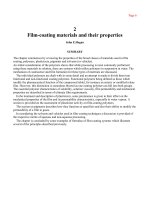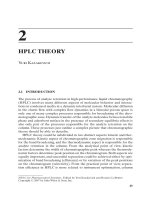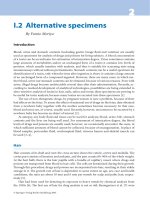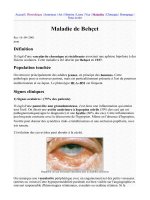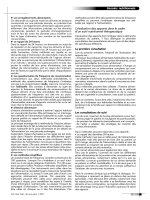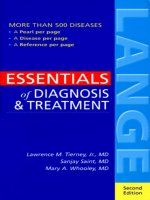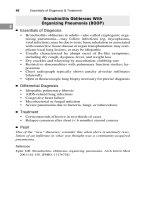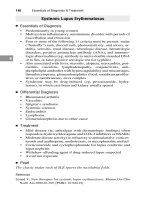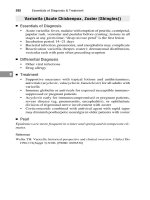DIAGNOSIS & TREATMENT - PART 2 pptx
Bạn đang xem bản rút gọn của tài liệu. Xem và tải ngay bản đầy đủ của tài liệu tại đây (477.15 KB, 54 trang )
Bronchiolitis Obliterans With
Organizing Pneumonia (BOOP)
■
Essentials of Diagnosis
• Bronchiolitis obliterans in adults—also called cryptogenic orga-
nizing pneumonia—may follow infections (eg, mycoplasma,
viral infection), may be due to toxic fume inhalation or associated
with connective tissue disease or organ transplantation, may com-
plicate local lung lesions, or may be idiopathic
• Usually characterized by abrupt onset of flu-like symptoms,
including dry cough, dyspnea, fever, and weight loss
• Dry crackles and wheezing by auscultation; clubbing rare
• Restrictive abnormalities with pulmonary function studies; hy-
poxemia
• Chest radiograph typically shows patchy alveolar infiltrates
bilaterally
• Open or thoracoscopic lung biopsy necessary for precise diagnosis
■
Differential Diagnosis
• Idiopathic pulmonary fibrosis
• AIDS-related lung infections
• Congestive heart failure
• Mycobacterial or fungal infection
• Severe pneumonia due to bacteria, fungi, or tuberculosis
■
Treatment
• Corticosteroids effective in two-thirds of cases
• Relapse common after short (< 6 months) steroid courses
■
Pearl
One of the “new” diseases; consider this when there is untimely reso-
lution of an infiltrate in what you thought was a community-acquired
pneumonia.
Reference
Epler GR: Bronchiolitis obliterans organizing pneumonia. Arch Intern Med
2001;161:158. [PMID: 11176728]
40 Essentials of Diagnosis & Treatment
2
Solitary Pulmonary Nodule
■
Essentials of Diagnosis
• A round or oval circumscribed lesion less than 5 cm in diameter
surrounded by normal lung tissue
• Twenty-five percent of cases of bronchogenic carcinoma present
as such; the 5-year survival rate so detected is 50%
• Factors favoring benign lesion: age under 35 years, asymptoma-
tic status, size under 2 cm, diffuse calcification, smooth margins,
and satellite lesions
• Factors suggesting malignancy: age over 45 years, symptoms,
size greater than 2 cm, lack of calcification, indistinct margins,
smoking history
• Skin tests, serologies, cytology rarely helpful
• Comparison with old chest radiographs essential; follow-up with
serial radiographs or CT scans often helpful; CT scan may reveal
benign-appearing calcifications
• Positron emission tomography (PET) scans are a newly emerg-
ing diagnostic modality
■
Differential Diagnosis
• Benign causes: granuloma (eg, tuberculosis or fungal infection),
arteriovenous malformation, pseudotumor, fat pad, hamartoma
• Malignant causes: primary, metastatic malignancy
■
Treatment
• Options include fine-needle aspiration (FNA), surgical resection,
or radiographic follow-up over 2 years; negative FNA does not
exclude malignancy due to high false-negative rate, unless a spe-
cific benign diagnosis is made
• Thoracic CT scan (with thin cuts through nodule) to look for
benign-appearing calcifications and evaluate mediastinum for
lymphadenopathy
• With high-risk clinical or radiographic features, surgical resection
is recommended
• In low-risk or intermediate-risk cases, close radiographic follow-
up may be justified
■
Pearl
In calcified pulmonary nodules, the first digit of the patient’s Social
Security number (always present on VA studies) suggests the specific
infectious cause.
Reference
Ost D et al: Evaluation and management of the solitary pulmonary nodule. Am
J Respir Crit Care Med 2000;162(3 Part 1):782. [PMID: 10988081]
Chapter 2 Pulmonary Diseases 41
2
Asthma
■
Essentials of Diagnosis
• Episodic wheezing, colds; chronic dyspnea or tightness in the
chest; can present as cough
• Some attacks triggered by cold air or exercise
• Prolonged expiratory time, wheezing; if severe, pulsus paradoxus
and cyanosis
• Peripheral eosinophilia common; mucus casts, eosinophils, and
Charcot-Leyden crystals in sputum
• Obstructive pattern by spirometry supports diagnosis, though may
be normal between attacks
• With methacholine challenge, absence of bronchial hyperreactivity
makes diagnosis unlikely
■
Differential Diagnosis
• Congestive heart failure
• Chronic obstructive pulmonary disease
• Pulmonary embolism
• Foreign body aspiration
• Pulmonary infection (eg, strongyloidiasis, aspergillosis)
• Churg-Strauss syndrome
■
Treatment
• Avoidance of known precipitants, inhaled corticosteroids in per-
sistent asthma, inhaled bronchodilators for symptoms
• In patients not well controlled on inhaled corticosteroids, long-
acting inhaled beta-agonist (eg, salmeterol)
• Treatment of exacerbations: oxygen, inhaled bronchodilators
(β
2
agonists or anticholinergics), systemic corticosteroids
• Leukotriene modifiers (eg, montelukast) may provide an option
for long-term therapy in mild to moderate disease
• For difficult-to-control asthma, consider exacerbating factors such
as gastroesophageal reflux disease and chronic sinusitis
■
Pearl
All that wheezes is not asthma, especially over age 45.
Reference
National Asthma Education and Prevention Program: Expert Panel Report 2:
Guidelines for the diagnosis and management of asthma. National Institutes
of Health, Publication No. 97-4051, Bethesda, MD, 1997.
/>42 Essentials of Diagnosis & Treatment
2
Chronic Cough
■
Essentials of Diagnosis
• One of the most common reasons for seeking medical attention
• Defined as a cough persisting for at least 4 weeks
• Chest auscultation for wheezing, nasal and oral examination for
signs of postnasal drip (eg, cobblestone appearance or erythema
of mucosa)
• Chest x-ray to exclude specific parenchymal lung diseases
• Consider spirometry before and after bronchodilator, metha-
choline challenge, sinus CT scan, and 24-hour esophageal pH
monitoring
• Bronchoscopy in selected cases
■
Differential Diagnosis
• Angiotensin-converting enzyme-induced cough
• Postnasal drip
• Sinusitis
• Asthma
• Gastroesophageal reflux
• Postinfectious cough—can last 4–6 weeks
• Bronchiectasis
• Chronic obstructive pulmonary disease
• Congestive heart failure
• Interstitial lung disease
• Sarcoidosis
• Bronchogenic carcinoma
■
Treatment
• Smoking cessation
• Treat underlying condition if present
• Trial of inhaled beta-agonist (eg, albuterol)
• For postnasal drip: antihistamines (H
1
-antagonists or may add
nasal ipratropium bromide)
• For suspected gastroesophageal reflux disease, proton pump in-
hibitors (eg, omeprazole)
■
Pearl
In undiagnosed chronic cough, think of ACE inhibitors and asthma;
these are far more common than appreciated.
Reference
Philp EB: Chronic cough. Am Fam Physician 1997;56:1395. [PMID: 9337762]
Chapter 2 Pulmonary Diseases 43
2
Chronic Obstructive Pulmonary Disease (COPD)
■
Essentials of Diagnosis
• Primarily consisting of emphysema and chronic bronchitis; most
patients have components of both
• Acute or chronic dyspnea (emphysema) or chronic productive
cough nearly always in a heavy smoker
• Tachypnea, barrel chest, distant breath sounds, wheezes or rhon-
chi, cyanosis; clubbing unusual
• Hypoxemia and hypercapnia more pronounced with chronic bron-
chitis than with emphysema
• Hyperexpansion with decreased markings by chest radiography;
variable findings of bullae, thin cardiac shadow
• Airflow obstruction by spirometry; normal diffusing capacity
(D
L
CO) in bronchitis, reduced in emphysema
• Ventilation and perfusion well-matched in remaining lung in
emphysema, not in chronic bronchitis
■
Differential Diagnosis
• Asthma
• Bronchiectasis
• α
1
-Antiprotease deficiency
• Congestive heart failure
• Recurrent pulmonary emboli
■
Treatment
• Cessation of cigarette smoking is most important intervention
• Clinical trial of inhaled anticholinergic agent, eg, ipratropium
bromide
• Pneumococcal vaccination; yearly influenza vaccination
• Supplemental oxygen for hypoxic patients (Pa
O
2
< 55 mm Hg)
reduces mortality
• For acute exacerbations, treat as acute asthma and identify under-
lying precipitant; if patient has low baseline peak flow rates,
antibiotics may be beneficial
• Lung reduction surgery in selected patients with emphysema
■
Pearl
The blue bloater pushes the pink puffer’s wheelchair (patients with
bronchitis have better exercise tolerance than those with emphysema).
Reference
Barnes PJ: Chronic obstructive pulmonary disease. N Engl J Med 2000;343:269.
[PMID: (UI: 10911010]
44 Essentials of Diagnosis & Treatment
2
Cystic Fibrosis
■
Essentials of Diagnosis
• A generalized autosomal recessive disorder of the exocrine glands
• Cough, dyspnea, recurrent pulmonary infections often due to
pseudomonas; symptoms of malabsorption, infertility
• Increased thoracic diameter, distant breath sounds, rhonchi, club-
bing, nasal polyps
• Hypoxemia; obstructive or mixed pattern by spirometry; decreased
diffusing capacity
• Sweat chloride > 60 meq/L
• Genetic testing for gene mutation can confirm diagnosis even if
sweat test is negative
■
Differential Diagnosis
• Asthma
• Bronchiectasis
• Congenital emphysema (α
1
-antiprotease deficiency)
• Pancreatic insufficiency
• Other causes of malabsorption
■
Treatment
• Comprehensive multidisciplinary therapy required, including gene-
tic and occupational counseling
• Inhaled bronchodilators and chest physiotherapy
• Antibiotics for recurrent airway infections guided by cultures and
sensitivities (high rate of resistant Pseudomonas aeruginosa and
Staphylococcus aureus infections seen)
• Pneumococcal vaccination; yearly influenza vaccinations
• Recombinant human deoxyribonuclease given by aerosol has
modest benefit
• Chest physiotherapy with a variety of devices may be beneficial
• Lung transplantation is the definitive treatment in selected patients
■
Pearl
Consider cystic fibrosis in young adults with recurrent pulmonary
infections; formes frustes are more common than once thought.
Reference
Rubin BK: Emerging therapies for cystic fibrosis lung disease. Chest 1999;
115:1120. [PMID: 10208218]
Chapter 2 Pulmonary Diseases 45
2
Foreign Body Aspiration
■
Essentials of Diagnosis
• Sudden onset of cough, wheeze, and dyspnea
• Localized wheezing, hyperresonance, and diminished breath
sounds
• Localized air trapping or atelectasis on end-expiratory chest radio-
graph
■
Differential Diagnosis
• Asthma with mucus plugging
• Bronchiolitis
• Pyogenic upper airway process (eg. Ludwig’s angina, soft tissue
abscess, epiglottitis)
• Laryngospasm associated with anaphylaxis
• Bronchial compression from mass lesion
• Substernal goiter
• Tracheal cystadenoma
■
Treatment
• Bronchoscopic or surgical removal of foreign body, often by rigid
bronchoscopy
• Emergency attention to airway—may require endotracheal in-
tubation
■
Pearl
An adult complaining of croup has a substernal goiter until proved
otherwise.
Reference
Reilly JS et al: Prevention and management of aerodigestive foreign body
injuries in childhood. Pediatr Clin North Am 1996;43:1403. [PMID:
8973519]
46 Essentials of Diagnosis & Treatment
2
Allergic Bronchopulmonary Aspergillosis
■
Essentials of Diagnosis
• Caused by an allergy to antigens of aspergillus species that colo-
nize the tracheobronchial tree
• Recurrent dyspnea, unmasked by corticosteroid withdrawal, with
history of asthma; cough productive of brownish plugs of sputum
• Physical examination as in asthma
• Peripheral eosinophilia, elevated serum IgE level, precipitating
antibody to aspergillus antigen present; positive skin hypersensi-
tivity to aspergillus antigen
• Infiltrate (often fleeting) and central bronchiectasis by chest radio-
graphy
■
Differential Diagnosis
• Asthma
• Bronchiectasis
• Invasive aspergillosis
• Churg-Strauss syndrome
• Löffler’s syndrome
• Chronic obstructive pulmonary disease
■
Treatment
• Oral corticosteroids often required for several months
• Inhaled bronchodilators as for attacks of asthma
• Treatment with itraconazole (for 16 weeks) improves disease
control
• Complications include hemoptysis, severe bronchiectasis, and
pulmonary fibrosis
■
Pearl
One of the three ways aspergillus causes disease—all different patho-
physiologically.
Reference
Stevens DA et al: A randomized trial of itraconazole in allergic broncho-
pulmonary aspergillosis. N Engl J Med 2000;342:756. [PMID: 10717010]
Chapter 2 Pulmonary Diseases 47
2
Bronchiectasis
■
Essentials of Diagnosis
• A congenital or acquired disorder affecting the large bronchi
causing permanent abnormal dilation and destruction of bron-
chial walls; may be a consequence of untreated pneumonia
• Chronic cough with copious purulent three-layered sputum, hemop-
tysis; weight loss, recurrent pneumonias
• Coarse, moist crackles; clubbing
• Hypoxemia; obstructive pattern by spirometry
• Chest x-rays variable, may show multiple cystic lesions at bases
in advanced cases
• High-resolution CT scan is essential for diagnosis in many cases
• Often associated with underlying systemic disorder (eg, cystic
fibrosis, hypogammaglobulinemia, IgA deficiency, common
variable immunodeficiency, primary ciliary dyskinesia), chro-
nic pulmonary infection (eg, tuberculosis, lung abscess), and
HIV infection
■
Differential Diagnosis
• Chronic obstructive pulmonary disease
• Tuberculosis
• Chronic lung abscess
• Pneumonia due to any cause
■
Treatment
• Smoking cessation
• Antibiotics selected by sputum culture and sensitivities
• Chest physiotherapy
• Inhaled bronchodilators
• Surgical resection in selected patients with unresponsive local-
ized disease or massive hemoptysis
• Complications include cor pulmonale, amyloidosis, and secondary
visceral abscesses (eg, brain abscess)
■
Pearl
Paragonimiasis is the most common cause worldwide, as bronchiecta-
sis is the world’s most common cause of hemoptysis.
Reference
Cohen M et al: Bronchiectasis in systemic diseases. Chest 1999;116:1063. [PMID:
10531174]
48 Essentials of Diagnosis & Treatment
2
Acute Tracheobronchitis
■
Essentials of Diagnosis
• Poorly defined but common condition characterized by inflam-
mation of the trachea and bronchi
• Due to infectious agents (bacteria or viruses) or irritants (eg, dust
and smoke)
• Cough is most common symptom; purulent sputum production
and malaise common
• Variable rhonchi and wheezing; fever is often absent but may be
prominent in cases caused by Haemophilus influenzae
• Chest x-ray normal
• Increased incidence in smokers
■
Differential Diagnosis
• Asthma
• Pneumonia
• Inhaled foreign body
• Inhalation pneumonitis
• Viral croup
■
Treatment
• Symptomatic therapy with inhaled bronchodilators, cough sup-
pressants
• Antibiotics are not recommended in all patients because they
shorten the disease course by less than 1 day
• Patients encouraged to stop smoking
■
Pearl
Sputum culture does not help in this disorder.
Reference
Gonzales R et al: Uncomplicated acute bronchitis. Ann Intern Med 2000;133:
981. [PMID: 119400]
Chapter 2 Pulmonary Diseases 49
2
Acute Bacterial Pneumonia
■
Essentials of Diagnosis
• Fever, chills, cough with purulent sputum production; early pleu-
ritic pain, often severe, suggests pneumococcal etiology
• Tachycardia, tachypnea; bronchial breath sounds with percussive
dullness and egophony over involved lung; findings may be more
pronounced after hydration
• Leukocytosis with left shift; low white count (< 5000/µL) asso-
ciated with poor outcome
• Patchy or lobar infiltrate by chest x-ray
• Diagnostic Gram stain or culture of sputum, blood, or pleural
fluid
• Causes include Streptococcus pneumoniae, Haemophilus influen-
zae, gram-negative rods, Staphylococcus aureus, legionella
• In ventilator-associated pneumonia, an invasive diagnostic strat-
egy including bronchoscopy may reduce mortality
■
Differential Diagnosis
• Lung abscess
• Pulmonary embolism
• Myocardial infarction
• Atypical or viral pneumonia
• Bronchiolitis obliterans with organizing pneumonia (BOOP)
■
Treatment
• Empiric antibiotics for common organisms after obtaining cultures
• Hospitalize selected patients (severe hypoxemia, more than one
lobe involved, poor host resistance factors, presence of coexist-
ing illness, leukopenia or marked leukocytosis, hypotension)
• Pneumococcal vaccine can prevent or lessen the severity of pneu-
mococcal infections in up to 90% of patients
■
Pearl
When gram-positive diplococci thrive in neutrophils, think staphylo-
cocci, not pneumococci.
Reference
Bartlett JG et al: Community-acquired pneumonia in adults: guidelines for man-
agement. The Infectious Diseases Society of America. Clin Infect Dis 1998;
26:811. [PMID: 9564457]
50 Essentials of Diagnosis & Treatment
2
Atypical Pneumonia
■
Essentials of Diagnosis
• Cough with scant sputum, fever, malaise, headache; gastrointesti-
nal symptoms variable
• Physical examination of lungs may be unimpressive
• Mild leukocytosis; cold agglutinins sometimes positive but not
diagnostic
• Patchy, nonlobar infiltrate by chest x-ray often surprisingly ex-
tensive
• Pathogens include mycoplasma, chlamydia, viral agents
• Typical and atypical pneumonia not always distinguishable by
clinical or radiographic features
■
Differential Diagnosis
• Bacterial pneumonia
• Pulmonary embolism
• Congestive heart failure
• Bronchiolitis obliterans with organizing pneumonia (BOOP)
• Idiopathic pulmonary fibrosis
• Hypersensitivity pneumonitis
■
Treatment
• Empiric antibiotic treatment with doxycycline, erythromycin,
or newer macrolide (eg, azithromycin) or fluoroquinolone (eg,
levofloxacin)
• Hospitalize as for bacterial pneumonia
■
Pearl
In psittacosis, the history of parrot exposure may be difficult to obtain
because of illegal importation of the bird.
Reference
Bartlett JG et al: Community-acquired pneumonia in adults: guidelines for man-
agement. The Infectious Diseases Society of America. Clin Infect Dis
1998;26:811. [PMID: 9564457]
Chapter 2 Pulmonary Diseases 51
2
Anaerobic Pneumonia & Lung Abscess
■
Essentials of Diagnosis
• Cough producing foul-smelling sputum; hemoptysis; fever, weight
loss, malaise
• Patients with periodontal disease, history of impaired deglutition
(eg, neurologic or esophageal disorder or altered consciousness)
are predisposed
• Bronchial breath sounds with dullness and egophony over in-
volved lung
• Leukocytosis; hypoxemia
• Chest x-ray density, often with central lucency or air-fluid level
• Sputum cultures reveal only mouth flora
■
Differential Diagnosis
• Tuberculosis
• Bronchogenic carcinoma
• Pulmonary mycoses
• Bronchiectasis
• Cavitary bacterial pneumonia
• Pulmonary vasculitis (eg, Wegener’s granulomatosis)
■
Treatment
• Clindamycin or high-dose penicillin (treatment for 6 or more
weeks)
• Surgery in selected cases (massive abscess; massive or persistent
hemoptysis)
• Supplemental oxygen as needed
• Bronchoscopic exclusion of carcinoma or foreign body aspiration
in patients with atypical features, especially edentulous patients
■
Pearl
A lung abscess in an edentulous patient is lung cancer until proved
otherwise.
Reference
Bartlett, JG et al: Community-acquired pneumonia in adults: guidelines for man-
agement. The Infectious Diseases Society of America. Clin Infect Dis 1998;
26:811. [PMID: 9564457]
52 Essentials of Diagnosis & Treatment
2
Pulmonary Tuberculosis
■
Essentials of Diagnosis
• Lassitude, weight loss, fever, cough, night sweats, hemoptysis;
may be asymptomatic, however
• Cachexia in many; posttussive apical rales occasionally present
• Apical or subapical infiltrates with cavities classic in reactivation
tuberculosis; pleural effusion in primary tuberculosis, likewise
mid-lung infiltration, but any radiographic abnormality is possible
• Positive skin test to intradermal purified protein derivative (PPD)
in most
• Mycobacterium tuberculosis by culture of sputum, pleural fluid,
gastric washing, or pleural biopsy; pleural fluid culture usually
sterile, however
• Increasing antibiotic-resistant strains
• Granuloma on pleural biopsy in patients with effusions; mesothe-
lial cells usually absent from fluid
■
Differential Diagnosis
• Bronchogenic carcinoma
• Bacterial pneumonia or lung abscess
• Fungal infection
• Sarcoidosis
• Pneumoconiosis
• Pleural effusion of asbestosis
• Other mycobacterial infections
■
Treatment
• Combination antituberculous therapy for 6–9 months; all regi-
mens include isoniazid, but rifampin, ethambutol, pyrazinamide,
streptomycin all have activity
• All cases of suspected M tuberculosis infection reported to local
health departments
• Hospitalization should be considered for those incapable of self-
care or likely to expose susceptible individuals
■
Pearl
With respect to pulmonary tuberculosis and HIV infection—if it looks
like tuberculosis it isn’t, and if it doesn’t it is.
Reference
Diagnostic Standards and Classification of Tuberculosis in Adults and Children.
This official statement of the American Thoracic Society and the Centers for
Disease Control and Prevention was adopted by the ATS Board of Directors,
July 1999. This statement was endorsed by the Council of the Infectious Dis-
ease Society of America, September 1999. Am J Respir Crit Care Med
2000;161(4 Part 1):1376. [PMID: 10764337]
Chapter 2 Pulmonary Diseases 53
2
Idiopathic Pulmonary Fibrosis
(Usual Interstitial Pneumonia)
■
Essentials of Diagnosis
• Insidious onset of dyspnea and dry cough in patients usually in
their sixth or seventh decades
• Inspiratory crackles by auscultation; clubbing
• Hypoxemia, especially exertional; antinuclear antibody and rheu-
matoid factor often positive but nonspecific
• Diffuse interstitial infiltration by chest x-ray, which may progress
to honeycombing pattern
• Restrictive pattern with decreased total lung capacity and diffus-
ing capacity (D
L
CO)
• High-resolution thoracic CT scan helpful
• Thoracoscopic and open lung biopsy are best methods for defin-
itive diagnosis; cellular pattern on bronchoalveolar lavage also
helpful
■
Differential Diagnosis
• Bronchiolitis obliterans organizing pneumonia (BOOP)
• Interstitial lung disease due to infection
• Drug-induced fibrosis (eg, bleomycin, nitrofurantoin)
• Sarcoidosis
• Pneumoconiosis
• Asbestosis
• Hypersensitivity pneumonitis
■
Treatment
• Supportive therapy, including supplemental oxygen
• High-dose oral corticosteroids ineffective
• Adjunctive cytotoxic therapy in selected patients may improve
outcome
• Early referral to lung transplantation center is critical for good
candidates; gamma interferon is a promising new therapy
■
Pearl
Progression from desquamative interstitial pneumonia to usual inter-
stitial pneumonia does not occur; the former is a nonspecific alveolar
response to smoking.
Reference
American Thoracic Society. Idiopathic pulmonary fibrosis: diagnosis and treat-
ment. International consensus statement. American Thoracic Society (ATS),
and the European Respiratory Society (ERS). Am J Respir Crit Care Med
2000;161(2 Part 1):646. [PMID: 10673212]
54 Essentials of Diagnosis & Treatment
2
Sarcoidosis
■
Essentials of Diagnosis
• A disease of unknown cause with an increased incidence in North
American blacks and Northern European whites
• Malaise, fever, dyspnea of insidious onset; symptoms referable
to eyes, skin, nervous system, liver, or heart also common; often
presents asymptomatically
• Iritis, erythema nodosum, parotid enlargement, lymphadenopathy,
hepatosplenomegaly
• Hypercalcemia (5%) less common than hypercalciuria (20%)
• Pulmonary function testing may show evidence of obstruction,
but restriction with decreased D
L
CO is more common
• Symmetric hilar and right paratracheal adenopathy, interstitial
infiltrates, or both seen on chest x-ray
• Tissue reveals noncaseating granuloma; transbronchial biopsy
gives high yield, even without parenchymal disease on chest film
• Increased angiotensin-converting enzyme levels are neither sen-
sitive nor specific; cutaneous anergy in 70%
■
Differential Diagnosis
• Tuberculosis
• Lymphoma, including lymphocytic interstitial pneumonitis
• Histoplasmosis or coccidioidomycosis
• Idiopathic pulmonary fibrosis
• Pneumoconiosis
• Berylliosis
■
Treatment
• Oral systemic corticosteroid therapy indicated for symptomatic
pulmonary disease, cardiac involvement, iritis unresponsive to
local therapy, hypercalcemia, central nervous system involve-
ment, arthritis, skin disease
• Asymptomatic patients with normal pulmonary function may
not require corticosteroids—they should receive close clinical
follow-up
■
Pearl
The only disease in medicine in which steroids reverse anergy.
Reference
Statement on sarcoidosis. Am J Respir Crit Care Med 1999;160:736. [PMID:
10430755]
Chapter 2 Pulmonary Diseases 55
2
Pulmonary Thromboembolism
■
Essentials of Diagnosis
• Seen in immobilized patients, congestive failure, malignancies,
and after pelvic trauma or surgery
• Abrupt onset of dyspnea and anxiety, with or without pleuritic
chest pain, cough with hemoptysis; syncope rare, but suggestive
of extensive disease
• Tachycardia, tachypnea, most common; loud P
2
with right-sided
S
3
characteristic but unusual; findings of peripheral venous throm-
bosis often absent
• Acute respiratory alkalosis and hypoxemia
• Characteristic perfusion defect on ventilation-perfusion scan,
confirmed by pulmonary angiography in selected patients
• Lower extremity ultrasound will demonstrate deep venous throm-
bosis in about half of cases
• Spiral CT scan is newly emerging diagnostic technique with
unclear utility
■
Differential Diagnosis
• Pneumonia
• Myocardial infarction
• Atelectasis
• Any cause of acute respiratory distress (eg, pneumothorax, aspi-
ration, pulmonary edema, or asthma) or pleural effusion
• Early sepsis
• Dressler’s syndrome
■
Treatment
• Anticoagulation: acutely with heparin for several days, instituting
warfarin concurrently and continuing for a minimum of 3 months
• Thrombolytic therapy initially in selected patients with hemo-
dynamic compromise, but no effect on mortality
• Intravenous filter placement in inferior vena cava for selected
patients not candidates for or unresponsive to anticoagulation
■
Pearl
Ten percent of pulmonary emboli originate from upper extremity veins.
Reference
Rathbun SW et al: Sensitivity and specificity of helical computed tomography
in the diagnosis of pulmonary embolism: a systematic review. Ann Intern
Med 2000;132:227. [PMID: 10651604]
56 Essentials of Diagnosis & Treatment
2
Primary Pulmonary Hypertension
■
Essentials of Diagnosis
• A rare disorder seen primarily in young and middle-aged women
• Defined as pulmonary hypertension and elevated peripheral vas-
cular resistance in the absence of lung or heart disease
• Progressive dyspnea, malaise, chest pain, exertional syncope
• Tachycardia, right ventricular lift, increased P
2
, systolic ejection
click, right-sided S
3
; may have evidence of right-sided heart fail-
ure (peripheral edema, hepatomegaly, ascites)
• Right ventricular strain or hypertrophy by electrocardiography
• Large central pulmonary arteries by chest x-ray, with oligemia
distally
• Characteristic plexogenic arteriopathy on pathologic examination
■
Differential Diagnosis
• Mitral stenosis
• Sleep apnea
• Chronic pulmonary embolism
• Autoimmune disease
• Ischemic heart disease
• Congenital heart disease
• Cirrhosis of the liver with portal hypertension
• Pulmonary veno-occlusive disease
■
Treatment
• Continuous intravenous prostacyclin infusion improves survival
• Empiric anticoagulation may confer survival benefit
• Other vasodilator agents of unpredictable and uncertain efficacy
• Bilateral lung or heart-lung transplantation important options; all
eligible patients should be referred to a transplant center for eval-
uation
■
Pearl
All murmurs of mitral stenosis may be missing in that condition, lead-
ing to an inaccurate diagnosis of primary pulmonary hypertension.
Reference
Gaine SP et al: Primary pulmonary hypertension. Lancet 1998;352:719. [PMID:
9729004]
Chapter 2 Pulmonary Diseases 57
2
Silicosis
■
Essentials of Diagnosis
• A typical pneumoconiosis: a chronic fibrotic lung disease caused
by the inhalation of various dusts
• History of extensive prolonged exposure to dust containing sili-
con dioxide (eg, foundry work, sandblasting, hard rock mining)
• Progressive dyspnea, often over months to years
• Dry inspiratory crackles by auscultation
• Characteristic changes on chest radiograph with bilateral fibrosis
and nodules (upper greater than lower lobes), hilar lymphadeno-
pathy with “eggshell” calcification
• Pulmonary function studies yield mixed obstructive and restric-
tive pattern
■
Differential Diagnosis
• Other inhalation pneumoconioses (eg, asbestosis)
• Tuberculosis (often complicates silicosis)
• Sarcoidosis
• Histoplasmosis
• Coccidioidomycosis
• Idiopathic pulmonary fibrosis
■
Treatment
• Supportive care; chronic oxygen if sustained hypoxemia present
• Chemoprophylaxis with isoniazid necessary for all silicotic pa-
tients with positive tuberculin reactivity (given the markedly in-
creased incidence of tuberculosis in silicosis)
■
Pearl
One of the associations with tuberculosis which is paradoxical; many
clinically similar processes do not share this association.
Reference
Mossman BT et al: Mechanisms in the pathogenesis of asbestosis and silicosis.
Am J Respir Crit Care Med 1998;157(5 Part 1):1666. [PMID: 9603153]
58 Essentials of Diagnosis & Treatment
2
Asbestosis
■
Essentials of Diagnosis
• History of exposure to dust containing asbestos particles (eg,
from work in mining, insulation, construction, shipbuilding)
• Progressive dyspnea, rarely pleuritic chest pain
• Dry inspiratory crackles common; clubbing and cyanosis occa-
sionally seen
• Interstitial fibrosis, later coalescing into nodules, is characteristic
(lower field greater than upper field); pleural thickening, plaques,
and diaphragmatic calcification common but unrelated to paren-
chymal disease; in some, exudative pleural effusion develops
before parenchymal disease
• High-resolution CT scan often confirmatory
• Pulmonary function testing shows a restrictive defect with a di-
minished D
L
CO often the earliest abnormality
■
Differential Diagnosis
• Other inhalation pneumoconioses (eg, silicosis)
• Fungal disease
• Sarcoidosis
• Idiopathic pulmonary fibrosis
• Mesothelioma
■
Treatment
• Supportive care; chronic oxygen supplementation for sustained
hypoxemia
• Legal counseling regarding compensation for occupational
exposure
■
Pearl
Remember that the highest exposures on ships or boats come from
sweeping the floor on submarines, not working on the structure of the
vessel.
Reference
Wagner GR: Asbestosis and silicosis. Lancet 1997;349:1311. [PMID: 9142077]
Chapter 2 Pulmonary Diseases 59
2
Pulmonary Alveolar Proteinosis
■
Essentials of Diagnosis
• May be idiopathic or secondary (ie, post lung infection, immuno-
compromised host)
• Progressive dyspnea and low-grade fever
• Physical examination often normal
• Hypoxemia; bilateral alveolar infiltrates suggestive of pulmonary
edema on chest radiography
• Characteristic intra-alveolar phospholipid accumulation without
fibrosis at open lung biopsy
• Superinfection with nocardia or fungi may occur
■
Differential Diagnosis
• Congestive heart failure
• Acute pneumonia
• Bronchiolitis obliterans with organizing pneumonia (BOOP)
■
Treatment
• Periodic whole lung lavage reduces exertional dyspnea
• Natural history variable with occasional spontaneous remissions
seen
■
Pearl
If the lab tells you they see faintly acid-fast organisms on a screen of the
sputum in a patient with new-onset “pulmonary edema,” here is your
diagnosis.
Reference
Wang BM et al: Diagnosing pulmonary alveolar proteinosis. A review and an
update. Chest 1997;111:460. [PMID: 9041997]
60 Essentials of Diagnosis & Treatment
2
Chronic Eosinophilic Pneumonia
■
Essentials of Diagnosis
• Fever, dry cough, wheezing, dyspnea, and weight loss—all vari-
able from transient to severe and progressive
• Wheezing, dry crackles occasionally appreciated by auscultation
• Peripheral blood eosinophilia present in most cases
• Peripheral pulmonary infiltrates on radiographs in many cases (ie,
“the radiologic negative” of pulmonary edema) shown to be eo-
sinophilic by bronchoalveolar lavage or open lung biopsy
■
Differential Diagnosis
• Acute infectious pneumonia
• Asthma
• Idiopathic pulmonary fibrosis
• Bronchiolitis obliterans with organizing pneumonia (BOOP)
• Allergic bronchopulmonary aspergillosis
• Churg-Strauss syndrome
• Other eosinophilic pulmonary syndromes (eg, drug or parasite-
related)
■
Treatment
• Corticosteroid therapy often results in dramatic improvement in
idiopathic cases; recurrence is common
• Most patients require corticosteroid therapy for a year or more
(sometimes indefinitely)
■
Pearl
Always pause and consider strongyloidiasis before giving steroids to a
patient with pulmonary disease and eosinophilia.
Reference
Allen JN et al: Eosinophilic lung diseases. Am J Respir Crit Care Med
1994;150(5 Part 1):1423. [PMID: 7952571]
Chapter 2 Pulmonary Diseases 61
2
Hypersensitivity Pneumonitis
■
Essentials of Diagnosis
• Work and environmental history suggesting link between activi-
ties and symptoms
• Acute form: 4–12 hours after exposure, onset of cough, dyspnea,
fever, chills, myalgias; tachypnea, tachycardia, inspiratory crack-
les; leukocytosis with lymphopenia and neutrophilia; eosinophilia
unusual
• Subacute or chronic form: exertional dyspnea, cough, fatigue,
anorexia, weight loss; basilar crackles
• Caused by exposure to microbial agents (eg, thermophilic acti-
nomyces in farmer’s lung, aspergillus), animal proteins (eg, bird
fancier’s lung) with resultant IgG complement deposition, and
chemical sensitizers (eg, isocyanates, trimetallic anhydride)
• IgG precipitating antibodies are not sensitive or specific—markers
of antigen exposure, not disease
• Pulmonary function tests reveal restrictive pattern and decreased
D
L
CO
• High-resolution thoracic CT scan reveals fine reticulonodular
pattern or diffuse ground-glass appearance
• Bronchoalveolar lavage reveals marked lymphocytosis
• Transbronchial or thoracoscopic lung biopsy can confirm diag-
nosis in unclear cases
■
Differential Diagnosis
• Sarcoidosis
• Asthma
• Atypical pneumonia
• Collagen-vascular disease, eg, systemic lupus erythematosus
• Idiopathic pulmonary fibrosis
• Lymphoma
■
Treatment
• Identification and removal of exposure is essential
• Consider systemic corticosteroids in subacute or chronic forms
■
Pearl
Bagassosis and sequoiosis are two examples: a history of exposure to
sugar cane or fallen lumber, respectively, makes the diagnosis.
Reference
Kaltreider HB. Hypersensitivity pneumonitis. West J Med 1993;159:570. [PMID:
8279154]
62 Essentials of Diagnosis & Treatment
2
Sleep-Related Breathing Disorders (Sleep Apnea)
■
Essentials of Diagnosis
• Excessive daytime somnolence or fatigue, morning headache,
weight gain, erectile dysfunction; bed partner may report restless
sleep and loud snoring
• Obesity, systemic hypertension common; signs of pulmonary
hypertension or cor pulmonale may develop over time in a few
• Erythrocytosis common
• Sleep study—either formal polysomnography or a screening
study—reveals periods of apnea
• Most cases are of mixed central or obstructive origin; pure cen-
tral sleep apnea is rare
■
Differential Diagnosis
• Alcohol or sedative abuse
• Narcolepsy
• Depression
• Seizure disorder
• Chronic obstructive pulmonary disease
• Hypothyroidism
■
Treatment
• Weight loss and avoidance of sedatives or hypnotic medications
mandatory
• Nocturnal nasal continuous positive airway pressure (CPAP) and
supplemental oxygen frequently abolish obstructive apnea
• Protriptyline effective in minority of patients
• Surgical approaches (uvulopalatopharyngoplasty, nasal septo-
plasty, tracheostomy) reserved for selected cases
■
Pearl
When a plethoric clinic patient nods off during the history, it’s sleep
apnea until proved otherwise; if the historian does, it’s a post-call res-
ident.
Reference
Piccirillo JF et al: Obstructive sleep apnea. JAMA 2000;284:1492. [PMID: (UI:
11000621]
Chapter 2 Pulmonary Diseases 63
2
64
3
Gastrointestinal Diseases
Gastroesophageal Reflux Disease
■
Essentials of Diagnosis
• Substernal burning (pyrosis) or pressure, aggravated by recum-
bency and relieved with sitting; waterbrash, dysphagia; nocturnal
regurgitation, cough, or wheezing common
• Esophageal reflux or hiatal hernia may be found by fluoroscopy
at barium study; iron deficiency anemia secondary to occult blood
loss may be encountered
• Manometry reveals incompetent lower esophageal sphincter;
endoscopy with biopsy may be necessary for diagnosis
• Esophageal pH monitoring helpful in excluding disease when
symptoms are present during monitoring
• Conditions associated with diminished lower esophageal sphinc-
ter tone include obesity, pregnancy, hiatal hernia, nasogastric tube,
recurrent emesis, and Raynaud’s phenomenon
■
Differential Diagnosis
• Peptic ulcer disease
• Cholecystitis
• Angina pectoris
■
Treatment
• Weight loss if indicated, avoidance of late-night meals or snacks,
elevation of head of bed
• Avoid substances reducing lower esophageal sphincter tone
(chocolate, caffeine, tobacco, alcohol, fried or fatty foods)
• Antacids, high-dose H
2
blockers, or proton pump inhibitors (eg,
omeprazole)
• Gastrointestinal motility stimulants (eg, bethanechol, metoclo-
pramide) in selected patients
• Surgical fundoplication via abdominal (Hill, Nissen) or thoracic
(Belsey) approach for rare cases refractory to medical management
■
Pearl
Eradication of Helicobacter pylori may actually worsen GERD by
increasing gastric acid secretion.
Reference
Katzka DA: Digestive system disorders: gastroesophageal reflux disease. West
J Med 2000;173:48.
• Achalasia
• Esophageal spasm
Copyright 2002 The McGraw-Hill Companies, Inc. Click Here for Terms of Use.
